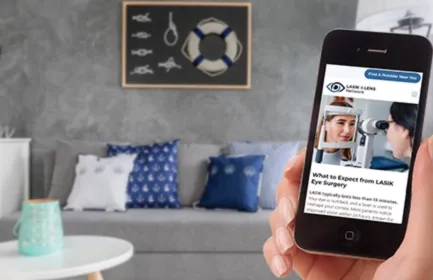LASIK Eye Surgery
Clearer Vision with Advanced Laser Eye Surgery
LASIK is a highly popular and effective laser vision correction procedure, reducing or eliminating the need for glasses or contact lenses. It uses advanced laser technology to reshape the cornea, improving how light focuses on the retina and resulting in clearer vision.
Whether you’re nearsighted, farsighted, or have astigmatism, LASIK offers long-lasting vision correction with minimal downtime.
What Does LASIK Treat?
LASIK is designed to correct a variety of common vision issues, including:

Myopia
(nearsightedness)
Condition: In myopic eyes, the cornea is too curved or the eye itself is too long, causing light to focus in front of the retina rather than on it.
Symptom: Difficulty seeing distant objects clearly.
Procedure: LASIK can reshape the cornea by flattening it, allowing light to properly focus on the retina, improving distance vision.

Hyperopia
(farsightedness)
Condition: In hyperopic eyes, the cornea is too flat or the eye is too short, causing light to focus behind the retina.
Symptom: Difficulty focusing on close objects.
Procedure: LASIK can correct this by steepening the corneal curvature, enabling light to focus correctly on the retina and improving near vision.

Astigmatism
(near and distance vision affected)
Condition: Astigmatism occurs when the cornea is irregularly shaped.
Symptom: Blurred or distorted vision at all distances.
Procedure: LASIK can smooth and reshape the cornea, correcting the uneven curvature to improve how light focuses on the retina, resulting in clearer vision.
What to Expect from LASIK Eye Surgery
LASIK is typically a quick and minimally invasive outpatient procedure, often lasting around 15 minutes. The laser itself is used for only a minute or two per eye.
Throughout the process, your eyes are numbed to ensure comfort, and a precise laser is used to reshape the cornea, improving how light focuses on the retina. Many patients find the procedure to be relatively painless.
The LASIK procedure includes the following steps:
Numbing the Eye
To begin, numbing eye drops are applied to ensure a pain-free experience throughout the procedure.
Creating the Corneal Flap
Next, a small flap is created on the surface of the cornea using either a microkeratome or a laser.
Lifting the Flap
The flap is then carefully lifted to reveal the underlying corneal tissue.
Reshaping the Cornea
A precise laser is used to reshape the cornea, correcting how light is focused on the retina for clearer vision.
Repositioning the Flap
At the end of the procedure, the flap is repositioned and left to heal naturally without the need for stitches.
Most patients notice an improvement in their vision immediately after their procedure. LASIK is known for its accuracy and quick recovery time, with many patients returning to their normal routine within 24 hours.
Is LASIK Right for You?
Many people are eligible for LASIK eye surgery, but candidacy depends on several factors. Eye health, prescription stability, and corneal thickness are crucial in determining LASIK eligibility. Taking our LASIK candidacy quiz is the first step toward clearer vision. Our network of experienced surgeons will guide you through the entire process, from consultation to recovery.
Learn more about LASIK candidacy
The Benefits of LASIK Eye Surgery
LASIK offers a wide range of benefits, including:
Clearer Vision
Improve your vision quality without corrective lenses.
Increased Freedom
Reduce or eliminate your need for glasses or contacts for more convenience.
Confidence Boost
Feel more confident in your appearance and daily activities.
Active Lifestyle
Enjoy sports, swimming, and travel without the hassle of eyewear.
Long-Term Savings
Spend less on glasses, contacts, and eye care over time.

Advanced LASIK Technology
At the LASIK and LENS Network, we’re committed to offering patients the most advanced technology in laser vision correction. Our providers use FDA-approved LASIK technology to offer precise, safe, and effective outcomes for vision correction procedures.
Types of LASIK
All-Laser LASIK
All-Laser LASIK, also known as bladeless LASIK, utilizes advanced laser systems to create the corneal flap. This technique offers greater precision and comfort compared to traditional methods, generally resulting in faster recovery and fewer risks during the procedure.
Custom Wavefront LASIK
Custom Wavefront LASIK is a cutting-edge approach that uses wavefront-optimized technology to deliver sharper, more personalized vision correction. By measuring specific points on the cornea, this method addresses even minor imperfections, reducing side effects such as glare and halos, especially for nighttime vision.
Contoura LASIK
Contoura LASIK, the latest FDA-approved LASIK technology, provides an even more refined treatment option. Using a high-definition camera, it maps over 22,000 unique points on the corneal surface, allowing for an extremely precise laser treatment. With Contoura LASIK, patients often achieve vision outcomes as sharp as 20/15, exceeding traditional LASIK results.
SMILE
SMILE (Small Incision Lenticule Extraction) is a minimally invasive laser eye surgery, similar to LASIK, and is ideal for patients with higher degrees of nearsightedness or thin corneas. Unlike LASIK, SMILE requires a smaller incision, preserving more of the corneal structure and typically leading to a quicker recovery.